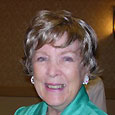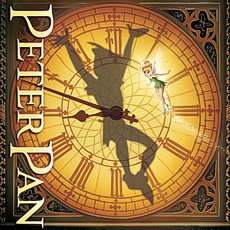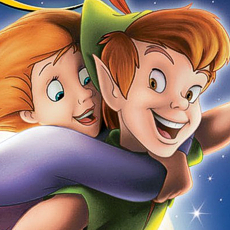As the release of the Peter Pan Platinum Edition DVD drew near, Animated News & Views’ Josh Armstrong was lucky enough to speak with two of the individuals responsible for bringing life to the cherished classic. The lovely ladies referred to are none other than Kathryn Beaumont, the voice of Wendy, and Margaret Kerry, the model for Tinker Bell. While both conversations regarded the latest DVD vehicle for Peter Pan, each actress offered her own perspective and memories on working with the talent behind the film.
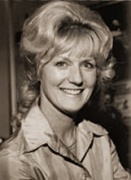 Born to entertainers Kenneth and Evelyn Beaumont on June 27, 1938, Kathryn seemed destined for stardom. After debuting in an Associated British production of It Happened One Sunday (1944), she was signed to a contract with MGM, where she obtained small roles in On an Island with You (1948), The Secret Garden (1949) and Challenge to Lassie (1949). In Garden, Walt Disney found the star of his animated adaptation of Alice in Wonderland (1951).
Born to entertainers Kenneth and Evelyn Beaumont on June 27, 1938, Kathryn seemed destined for stardom. After debuting in an Associated British production of It Happened One Sunday (1944), she was signed to a contract with MGM, where she obtained small roles in On an Island with You (1948), The Secret Garden (1949) and Challenge to Lassie (1949). In Garden, Walt Disney found the star of his animated adaptation of Alice in Wonderland (1951).
Although the role was for voice acting, Beaumont found herself also working as a live-action reference model for the Wonderland animators. With assistance from a series of contrivances, the thespian enacted many of the stunts her animated counterpart would experience. Likewise, Beaumont would do extensive work endorsing Wonderland upon its release, engaging on a promotional tour.
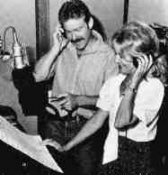 Two weeks after the tour ended, Disney cast Beaumont once more, this time in the part of Wendy Darling for Peter Pan (1953). Similar to her work for Wonderland, Beaumont served as the voice and live-action reference for the character. Following her work in Pan, the actress’ next role was that of a full-time high school student in real-life. Afterward, she obtained a teaching credential via the University of Southern California.
Two weeks after the tour ended, Disney cast Beaumont once more, this time in the part of Wendy Darling for Peter Pan (1953). Similar to her work for Wonderland, Beaumont served as the voice and live-action reference for the character. Following her work in Pan, the actress’ next role was that of a full-time high school student in real-life. Afterward, she obtained a teaching credential via the University of Southern California.
In the early ’80s, Beaumont returned to voice acting for Disney. Since then, she has been heard as the voice of Wendy and Alice in Disney projects ranging from the video games Villains’ Revenge (1999) and Kingdom Hearts (2002), to the Disneyland attractions Alice in Wonderland (1958-) in Fantasyland and Fantasmic! (1992-), to the television series House of Mouse (2001-02). Beaumont’s dedication to the company led to her being named a Disney Legend on October 16, 1998. Meanwhile, she continues to be helpful in promoting the re-releases of Disney animated movies starring her voice, with the latest DVD release of Peter Pan being no exception.
Animated Views: Why did you decide to try voice acting?
Kathryn Beaumont: As a small child, I don’t really think you make those decisions. I was in a couple of films. I think I then met with [Disney].
 I was so young at the time, I don’t have much of a memory or an understanding of the stuff that perhaps went on, except that suddenly, someone had seen me and wanted to put me in a small role in a British film. I guess there must have been a couple of those things. MGM had seen some of those things, and they were interested in doing some more British stories. They wanted to get some fresh, new British people who had the accent for authenticity. So they put me under contract and brought me out to America. I did two or three small roles there.
I was so young at the time, I don’t have much of a memory or an understanding of the stuff that perhaps went on, except that suddenly, someone had seen me and wanted to put me in a small role in a British film. I guess there must have been a couple of those things. MGM had seen some of those things, and they were interested in doing some more British stories. They wanted to get some fresh, new British people who had the accent for authenticity. So they put me under contract and brought me out to America. I did two or three small roles there.
In the meanwhile, Walt Disney was looking for his Alice. He was looking for a voice that was pleasing to both American ears and British ears. So, I read for the part, because he was looking all over the country. There were lots of little girls looking for the part. Fortunately for me, he did find that my voice was the most suitable. So there is the story, in a nutshell. I just feel fortunate that I had an opportunity to have such a special experience at such a young age.
AV: What was your first interaction with Walt Disney like?
KB: Well, I was a bit nervous, because I knew him so well from England. Disney was well-known, I guess, internationally, even in those days. So many films of his were shown. I had seen Snow White and the Seven Dwarfs, and I had seen Fantasia and, of course, Bambi. I was just in love with Bambi, and I don’t know how many times I had gone to see that. So, Walt Disney was someone I knew very well, who created all of this.
 Then, when the opportunity came that I was actually going to work with Walt Disney, I was rather in awe. The first opportunity to meet him was when we signed the contract. They brought me to the studio and up to the third floor, where his office was. That was where we had the ceremony of signing the contract.
Then, when the opportunity came that I was actually going to work with Walt Disney, I was rather in awe. The first opportunity to meet him was when we signed the contract. They brought me to the studio and up to the third floor, where his office was. That was where we had the ceremony of signing the contract.
He was just a very easy-going and easy-to-talk-to person. He did have two daughters who weren’t too much older than I was, so he was used to being around children. He knew how to make them feel comfortable. I was not very comfortable, so I can remember that he sat me on a couch with him. He used an Alice book, and he said, “Let’s go through this story here and see, and I can give you some ideas about some of the things we’re planning on doing with Alice.” So, we sat there and looked at the picture book and talked about what was going to happen and what the plan was, in such terms that a small child would be able to relate to. I just said, “Oh, this person is just so easy to be around.” I immediately felt comfortable with him.
AV: Could you describe the test performance that landed you the role of Alice in Alice in Wonderland?
 KB: Unfortunately, these events happened so long ago, I couldn’t really even tell you what sequence it came from. There were some lines that they had me read that were probably thought of for one of the sequences. But it was sort of a blur. I guess I was probably nine [years old], at the time. So, that’s back a long time.
KB: Unfortunately, these events happened so long ago, I couldn’t really even tell you what sequence it came from. There were some lines that they had me read that were probably thought of for one of the sequences. But it was sort of a blur. I guess I was probably nine [years old], at the time. So, that’s back a long time.
No, I don’t remember that. I just remember that I did go to the studio, and I did record – I think I did record a couple of times. Then, suddenly, we got the phone call telling us that Walt had made up his mind with what he wanted to do – to have me do the voice.
AV: Were you Walt’s first choice for the role of Wendy?
KB: I have no knowledge of that. What happened, in my view, was that we were finishing up with Alice. Peter Pan had been in the story process for years. It seriously got underway story-wise during the time that Alice was being worked on. Toward the end of that, they had made their decision. I had the British voice for Wendy as I was reaching a similar age level – preadolescence – as Wendy was. And it just fell into place, really, so it went from one to the other.
AV: Doing the roles of Alice and Wendy, which did you enjoy more: voice acting or acting as a live-action reference?
KB: The experiences were totally different, and each one of them had something special to bring to it. I liked the recording part, because it was a new experience. You had a script in front of you, and you still worked along with the other actors, which was a comfortable thing to do on the soundstage, radio-style.
Then, they wanted me to do the live-action reference. That was more like live-action that I had done in the past. But it was different again, because rather than memorizing lines and then going through your scenes, the recording was already done. So, when you did your scenes, you had to speak in synchronization with what was on the recordings. They would play back the recording when the scene started, and you mouthed those lines over again. So, it was a whole different world, in terms of doing the live-action part.
With Alice, there were so many contraptions rigged up, because you know those sets were not sets that you would see in a film that the public went to see. So, you would have planks and boards and hardly anything much out there. But it was just so that when you made movement, that gave the artists ideas about natural movements. With Alice, there were lots and lots of very curious contraptions. That got to be a lot of fun and challenging with what kinds of things they were going to do next.
Wendy – the main thing, of course, was the flying, and they had me hooked up to a harness. The idea of a lack of gravity and floating in space – that was a concept that the artists found a little difficult. They needed to have something to go by to show lifting off the ground and floating and landing on the ground and what the body does when that happens. They needed that kind of reference very much. That was probably the most unique thing about my Wendy part. But the Alice part was filled all sorts of fun things.
AV: What would you say was your most memorable experience with Walt?
KB: That’s a tough one to think through. I didn’t get to know him super well, simply because I was a child. You know, a child’s relationship with an adult is a totally different one than when you’re with your peers. So, I didn’t get that chance to know him on an equal basis.
A lot of it was observation and just seeing the things he did. I was always amazed at how realistic he was and easygoing and very gracious. I can remember we had what they called ‘dailies,’ and that memory was when he came in and sat down in the tiny theater that we saw the dailies in. He wanted to see what was going on and give any ideas, if he had some thoughts as to what went on for that day. It got very crowded. Some lady walked in, and there was no seat left. He stood up and said, ‘Oh, please, I can stand – you sit down here.’ Stuff like that stands out in a child’s memory. ‘Oh my goodness, how nice that was! He’s the head of the studio, and look what he did!’ Things like that are things I remember as a child with him.
AV: Did you and Walt ever disagree about anything, such as how a certain line should be read?
KB: He didn’t involve himself that much with that sort of thing. It was up to the voice director. There was a director of the audio part. Then, there was a director for the live-action part. Those were the people I took direction from.
Basically, as a child, just like you do with any adult – and at that age, too – I don’t think I really questioned anything. I just felt that they knew what they were doing, and that I would fulfill what was necessary – what they needed me to do – to the best of my ability. That’s all I really can remember.
AV: Were you contacted about reprising your role as Wendy for the Peter Pan sequel, Return to Never-Land?
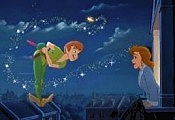 KB: Oh yeah, we did the whole film – we recorded it. But they made different decisions after the film was completely recorded. They had – I don’t know what problems. But you know how sometimes when films are made, they look at the way it is at that time and decide they want to make changes, or they’re not sure if certain things are going to work, and they completely redo them. That’s what happened with this film. They just dropped everything, including most of the voices. I think they changed most of the voices, including mine. So that was the way it went.
KB: Oh yeah, we did the whole film – we recorded it. But they made different decisions after the film was completely recorded. They had – I don’t know what problems. But you know how sometimes when films are made, they look at the way it is at that time and decide they want to make changes, or they’re not sure if certain things are going to work, and they completely redo them. That’s what happened with this film. They just dropped everything, including most of the voices. I think they changed most of the voices, including mine. So that was the way it went.
AV: Do you recall any advice Walt might have given you?
KB: Actually, when I was finished with Wendy, I was at a crossroad, because there were opportunities for even further voice work, and then I was thinking that I was ready for high school. It was a chance, at that point, to have a different kind of experience with my education and with peer relationships. I didn’t quite know what I should do.
I did go talk with him. He sat down with me, and he understood my plight and my sort of dilemma as to which way to go. He said, ‘You know, you’re at the beginning of your life. There are always going to be good opportunities for you. If you feel you need to take a break, do it. And while you’re taking the break, if you have a desire to work on your skill and take classes and do that sort of thing for acting, do that. Do what you feel comfortable with. You always have a place here. As you become an adult, you will have different opportunities for different kinds of roles. It’s not going to be the end of the world because you’ve made a decision to go and do that.’
That, in essence, was what he talked about with me. So, yes, he did give me advice. He did help me make difficult decisions.
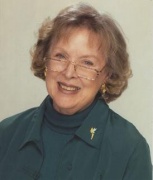 Of course, Wendy is not the only female companion for “the boy who wouldn’t grow up” in Disney’s Peter Pan. Where would be Peter Pan be without his faithful assistant Tinker Bell? To find inspiration for a new incarnation of the cherished character, Disney animators looked to the spirited Margaret Kerry.
Of course, Wendy is not the only female companion for “the boy who wouldn’t grow up” in Disney’s Peter Pan. Where would be Peter Pan be without his faithful assistant Tinker Bell? To find inspiration for a new incarnation of the cherished character, Disney animators looked to the spirited Margaret Kerry.
Born around 1930, Kerry’s first big acting gig came in the form of a smaller role in the Our Gang episodes Teacher’s Beau (1935), The Pinch Singer (1936) and Aladdin’s Lantern (1938). Next in line for her were the features If You Knew Susie (1948), Canon City (1948) and The Sickle or the Cross (1949). She then starred in one of television’s earliest sitcoms, The Ruggles (1949-1952), portraying Sharon, the daughter of Charles Ruggles. Likewise, Kerry found a part as Jane Carter in the Lone Ranger adventure The Squire (1950).
At the age of 22, Kerry learned of Walt Disney’s search for a live-action reference for Tinker Bell in the animated Peter Pan. Following an enthusiastic audition, she landed the job as the model for Miss Bell. Yes, despite rumors of Marilyn Monroe serving as the inspiration, the famous fairy’s silhouette belongs to none other than Margaret Kerry. The actress also provided the voice and physical form for one of Peter Pan‘s red-haired mermaids.
To this day, Kerry remains passionate about her work as Tinker Bell. Memories of her involvement with the character may be read in her autobiography Tinker Bell Talks. Meanwhile, Kerry is thrilled at the Platinum Edition DVD release for Pan. “Isn’t it wonderful?” she excitedly asks, regarding the DVD’s bonus features. “You know, most of those things, I didn’t know. I’m sitting there like the rest of you going, ‘[Gasp] I didn’t know that!’ Oh my goodness, it was like I was on the inside with everybody, watching it being created. It’s beautifully done.
“I think it’s a wonderful way to introduce Tinker Bell to all the new little wee ones who are coming along, because they know Tinker Bell, but they don’t really know where she came from,” Kerry continues. “It’s not Peter Pan or Wendy or Captain Hook who flies over the castle at the Disney park! It’s Tinker Bell! You know, lots of kids – that’s really what they connected with, so here they can see who she is and where she came from.”
Animated Views: Why did you want the role of Tinker Bell?
Margaret Kerry: Back in those days, I was doing many different assignments. I was working at Fox under a contract with the movie that I was assistant dance director of. So you always have an agent – and this is the strangest business. You go and do a good job for a director on TV or in a movie, and they love your work. And you know what they say to you next? ‘If we have another part for you, we’ll call you.’ And you’re out on the street again, looking for another gig! It’s not like other places, where you do a good job and you get promoted. So, you’re always looking for the next assignment.
At that time, I was told that they were interviewing for this little 3½-inch fairy, who didn’t talk, and would I be interested, and could I get out of a day from Fox to go and interview for it. I said, ‘Yes.’ That was one of the happiest days of my life, because walking on the Disney lot is one of the happiest moments you can imagine. The creativity sort of bowls you over as you walk down the street with the little touches of Goofy Lane and such – all of these touches are so happy. I was used to working at Columbia and MGM and Warner Bros., with none of those touches. It’s just a big concrete building.
It’s still, to this day, when I go over and see them [at Disney] – and I do that often – you have the same feeling. So, I was thrilled to be there! Anybody would have been. And then, when I was cast as Tinker Bell, oh, that was just frosting on the cake!
AV: How did you get the role of the red-haired mermaid in Peter Pan?
MK: Well, because I had done such a good job as the reference model for Tinker Bell, and I am a dancer and an actress and a mime. And I was doing voiceovers; I had been on radio. So they brought us in. June Foray – she’s just a dear friend of mine and a wonderful lady – and Connie Hilton and I stood in front of the microphones and did the lines. ‘Ooh, Peter, we’re so happy to see you!’ was one of them.
Then we decided that we could be the reference models. So they tied our legs together and put us on these ramps that looked like stones that we would actually be sitting on, as the mermaids. And we did the reference work.
AV: Could you elaborate on what it was like working with Walt Disney?
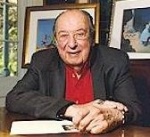 MK: Unfortunately, I did not work that much with Walt Disney. He came over and would check on us once in a while. I worked with the great Marc Davis, who designed the Pirates of the Caribbean and Cruella de Vil and young Bambi. He was one of the famous Nine Old Men of Disney animation. I got to work with him and [Clyde] Geronimi and Wilfred Jackson, who was a director of it. So, I got to work with these creative geniuses, who would sit there and draw things for me and show me what they really wanted.
MK: Unfortunately, I did not work that much with Walt Disney. He came over and would check on us once in a while. I worked with the great Marc Davis, who designed the Pirates of the Caribbean and Cruella de Vil and young Bambi. He was one of the famous Nine Old Men of Disney animation. I got to work with him and [Clyde] Geronimi and Wilfred Jackson, who was a director of it. So, I got to work with these creative geniuses, who would sit there and draw things for me and show me what they really wanted.
One day, they were asking me to be very upset and stomp off the camera range as Tinker Bell. I said to Marc, ‘Well, how upset?’ and I made the different kinds of faces. ‘A little upset or really bug-eyed? What do you want?’ This man took a piece of paper and a pencil and, within 30 seconds, had drawn the face of Tinker Bell with exactly the look that he wanted and turned it around and showed it to me. He said, ‘I want it to be this upset.’ I realized right then and there I was looking at an absolute, utter genius. You’ve never seen a hand fly that fast and come out with a drawing of me. I mean, I look like that – Tinker Bell looks like me, and I look like her. It was remarkable.
I worked with them mostly. When Mr. Disney would come over and see what was going on, he would smile, he would nod, he would chat for a little bit. Then, he was off working on another project – something with Buddy Epson particularly. I never did find out which film it was.
In the projection room, when we saw the pencil tests, he [Mr. Disney] was there. I was used to being at these big studios, where when the boss of the studio would walk in, there would practically be trumpeters going first. You know, ‘Studio boss here! Everything stop! Everybody kneel down!’ You got that feeling. It wasn’t that bad. But that was the feeling.
So, I’m in the projection room. I didn’t know what a pencil test was, so they invited me. The room was jammed, because half of the people who were working on the project didn’t think Tinker Bell was going to work. They were pretty sure that they were going to have to redesign her and work on something else. Mr. Disney evidently came in late. He was behind me. Somebody said, ‘Here, Walt, take my seat.’ I heard Mr. Disney say, ‘No, you were here on time. I’m fine.’ And I’m going, “[sighs] I love that man!” He was the head of the studio! And no trumpets – he just stood against the wall like the rest of them, and then left a little bit later. He nodded that everything was okay.
That was when I worked with him. I wish I had worked with him more. I would have also loved to have known his brother, Roy Disney, who made everything happen for Walt Disney. Without Roy, Disneyland and all the things that we know would not have happened. We forget that sometimes.
AV: Do you recall the very first time you saw Tinker Bell?
MK: Yes, it was the day I went for the interview. They had everything pinned up on the wall, and they showed me the sketches of her so immediately I could get the drift of what they wanted for this little pixie. I’m rather pixie-like. I’ve been known as pert and perky all my life. So, I could immediately picture what they wanted her to look like.
Then, I did the scene for them – right there in the office – of landing on the famous mirror on Wendy’s dresser where she looks down and preens herself and then measures her hips and is not very happy. I did that scene. They loved it and asked whether it would be convenient for me to come to work next Tuesday. I had never been asked, in all of the years since I started in show business when I was four years old, if it would be convenient. I said, ‘Yes, it would.’
What do you like about Tinker Bell?
AV: What do I like about Tinker Bell? Well, she’s a very memorable character.
MK: Yes. And why?
AV: Well… [brief pause for thought]
MK: It’s hard, isn’t it? It’s hard to put into words. I have asked hundreds of people that I’ve talked to, going around the country and stuff. Very few of them can ever put it into words, because – I think – Tinker Bell touches people emotionally. They connect with her. She’s like a 13-year-old who is just learning about what the world is. So, everything is new and fresh and childlike to her.
She examines a jug; she sees a mirror for the first time. We all sort of remember that and relive it with her. She’s naïve, but she’s going on an adventure with her buddy, Peter Pan. And we all would like to go on an adventure, because life is an adventure.
She’s very courageous. You know, it takes courage to fly. It’s not something you do easily. I can tell you, because they were going to strap me in that flying rig, and I was fearful of it. They decided that Tinker Bell did not need to get into that rig, because Tinker Bell darts. She does not glide like Peter and the Darling children. So, I didn’t have to get into the rig, and I thought, ‘You know, it takes courage to fly.’ I always say Tinker Bell has the courage to fly because she takes herself lightly. If you take yourself seriously, you’ll never go on an adventure. What do you think?
AV: It sounds great to me!
MK: [Laughs] Did you know that there is a controversy about the difference between fairy dust and pixie dust?
AV: No, I didn’t.
MK: Yeah – oh, there’s quite a bit of argument about it! My thoughts are pixie dust is what Tinker Bell uses, and fairy dust is what we really saw when she flew in the window of Walt Disney’s office to open up the television show with Mr. Disney. I’ve always thought that she used his fairy dust that he created. I think those are two different things, because the fairy dust took us to all different sorts of lands. We met all different sorts of people through the fairy dust out of Walt Disney’s office. I tell people this, and they go, ‘Yes! That’s the difference!’ Fairy dust takes us on an adventure throughout the world or out into space. Pixie dust is what Tinker Bell uses herself.
AV: Have you been involved with the Disney Faeries line, including the upcoming Tinker Bell movie?
MK: I’ve been over there since they started making the movie, chatting with them and giving them some ideas from Tink’s point of view. They’ve been sketching me as I’m there. They’re just amazed that my legs look exactly the same as Tinker Bell’s. I don’t know why they’re amazed – ’cause they’re hers!
But they’re doing a grand job. I think some of the animation that they’ve done is magical. Now, she’s a little different, no question about it. But I love her. They’re doing a great job. They really are. I’m happy to be a part of it.
To learn more about Kathryn Beaumont and Margaret Kerry, visit KathrynBeaumont.com and Tinker Bell Talks.

From everyone at Animated News & Views, special thanks are sent to Ms. Beaumont and Ms. Kerry for allowing themselves to be interviewed. Likewise, we appreciate Mac McLean for arranging the discussions.



